
* The article was originally published on ONN's Datayo platform.
Japan Revisiting Its Missile Defence Strategy
On 18 December 2020, the Japanese Cabinet decided on a new policy to upgrade its missile defence systems to cope with the evolving missile threats in the surrounding region. This decision followed an earlier statement made by the former Japanese Prime Minister Shinzo Abe.
On 11 September 2020, then-Prime Minister Abe issued a statement regarding the next step in Japan's renewed missile defence architecture, following Japan's earlier decision in June to abandon the introduction of the land-based missile defence system, Aegis Shore. [1] The statement was made just 5 days before Mr. Abe stepped down from the position of prime minister on 16 September. Mr. Abe revealed that the Japanese Government had been considering "a new course for security policy regarding countering missiles." [2]
The statement reflects the sense of urgency held by Mr. Abe and the national security practitioners within the government regarding the need for Japan to upgrade its missile defence architecture in order to address the multiple emerging security challenges.
The Japanese Government is increasingly concerned about the development of the missile capabilities of the Democratic People's Republic of Korea (DPRK) and the People's Republic of China (PRC), especially in light of their improved capabilities for saturation and/or surprise attacks by missiles with enhanced maneuverability. In addition, the Japanese Government is worried that hypersonic glide vehicles, hypersonic cruise missiles or a fleet of UAVs in a formation flying for conventional attacks that are currently developed by China and Russia could become a game-changer for near-future warfare. These developments had not been foreseen in Japan's existing missile defense strategy.
Meanwhile, speculations have been brewing with regard to whether Japan might abandon its traditional policy of exclusive self-defence, drift from its alliance with the United States or start developing indigenous strike capabilities against military targets within its adversaries' territories.
While Mr. Abe stepped down as the prime minister, he continues to remain a key figure in the ruling party and exert influence in the shaping of the discussion within the ruling party, pressing for Japan's development of counterforce strike capabilities on foreign soil in coordination with the United States military. Meanwhile, his successor, Prime Minister Yoshihide Suga, appears to maintain a certain distance from Mr. Abe's position and has yet to make his decision on whether or not to adopt such counterforce strike capabilities.
This paper provides an overview of Japan's efforts to upgrade its missile defence systems to meet with the evolving security environment, and the debates surrounding such efforts within Japan. The paper also analyses the key factors shaping the future course of Japan's missile defence strategy.

The Japanese Aegis destroyer Atago just after launching the SM3 Block 1B interceptor off the coast of Hawaii, 12 September 2018, Source: Japan MOD [3]
Japan’s Missile Defence Architecture

Conceptual image of Japan’s ballistic missile defence architecture, Source: Japan MOD [4]
Japan's missile defence architecture is designed to intercept incoming ballistic missiles (BMs) through a multi-layered defense system with upper tier interception by Aegis equipped destroyers and lower tier interception by Patriot PAC-3. The systems are mutually interconnected and coordinated through the Japan Aerospace Defense Ground Environment (JADGE) system. [5]
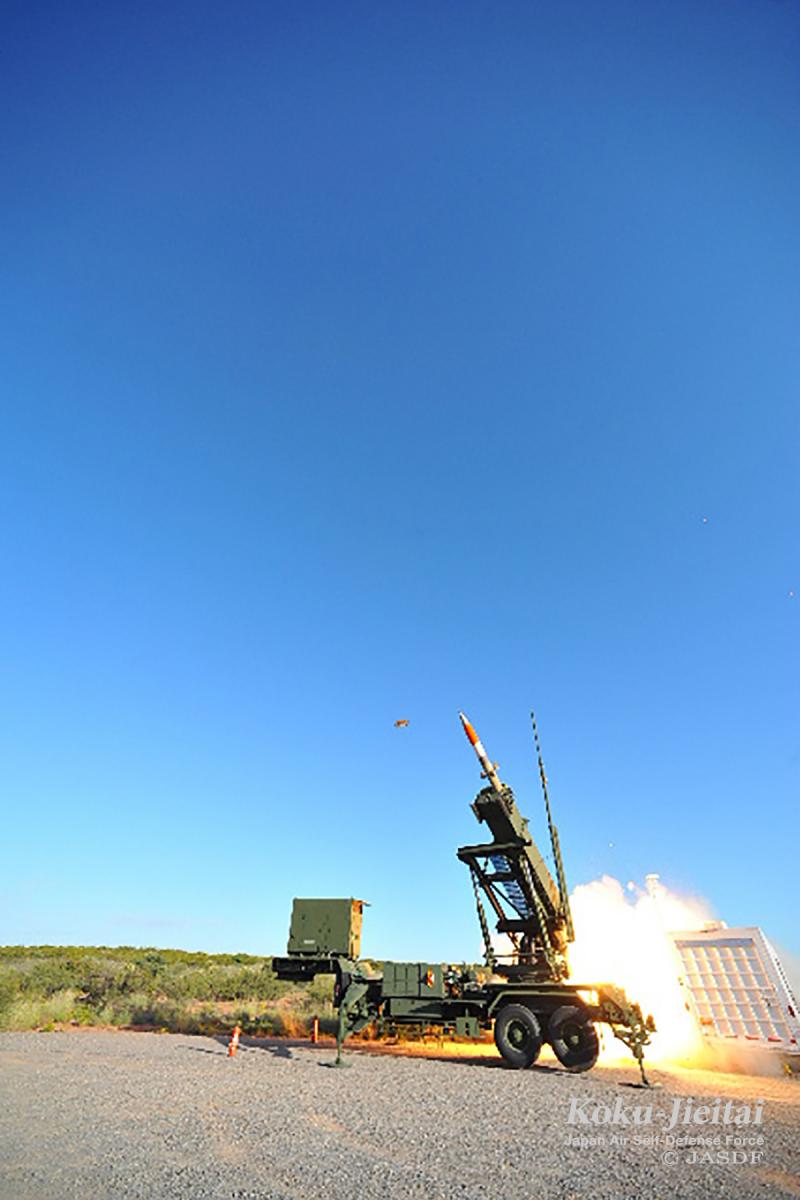
Photo. PATRIOT Pac 3 system, Source: Japan MOD [6]
By the end of 2020, eight Aegis-equipped destroyers are slated to become capable of undertaking ballistic missile defence (BMD) activities. [7] Japan and the United States have jointly developed an advanced interceptor, SM-3 Block IIA, which is expected to be capable of intercepting incoming BMs equipped with interception avoidance measures, such as a decoy, and BMs that are launched with a lofted trajectory. [8]
As for the Patriot PAC-3 system, upgraded PATRIOT surface-to-air guided missiles are slated to be deployed to 16 fire squadrons throughout Japan by 31 March 2024. [9]
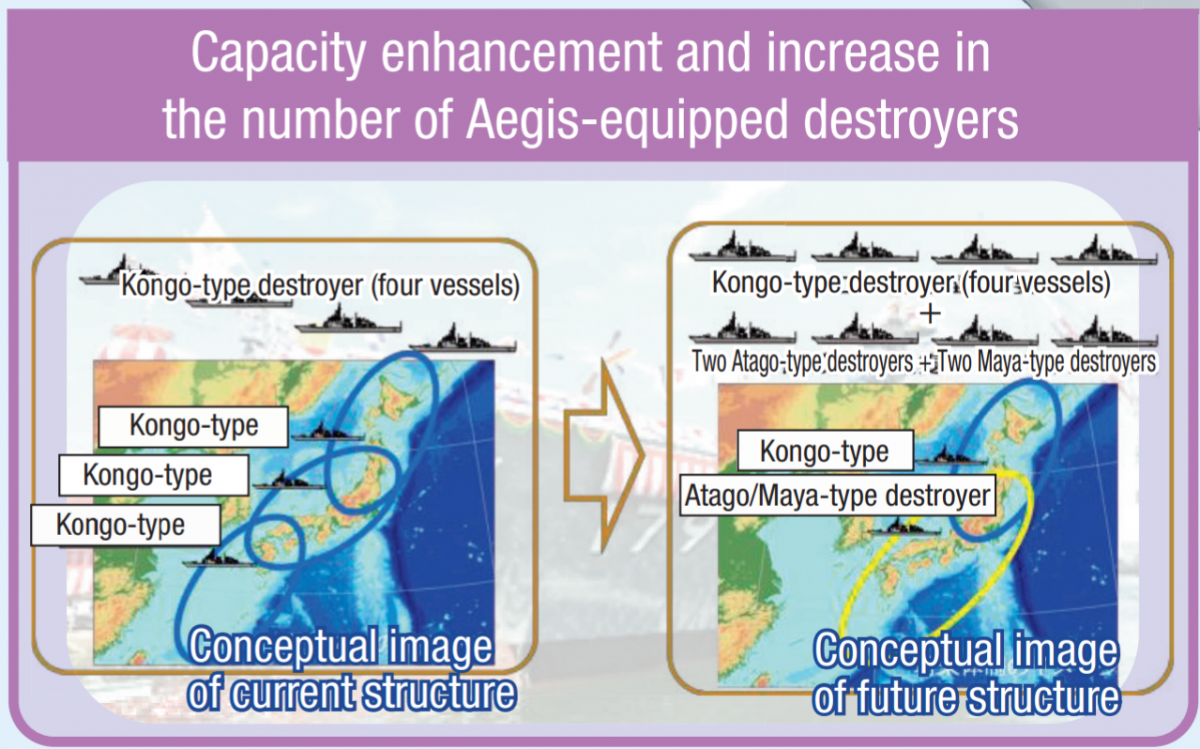
Conceptual image of the geographical coverage areas of the Aegis-equipped destroyers, Source: Japan MOD [10]
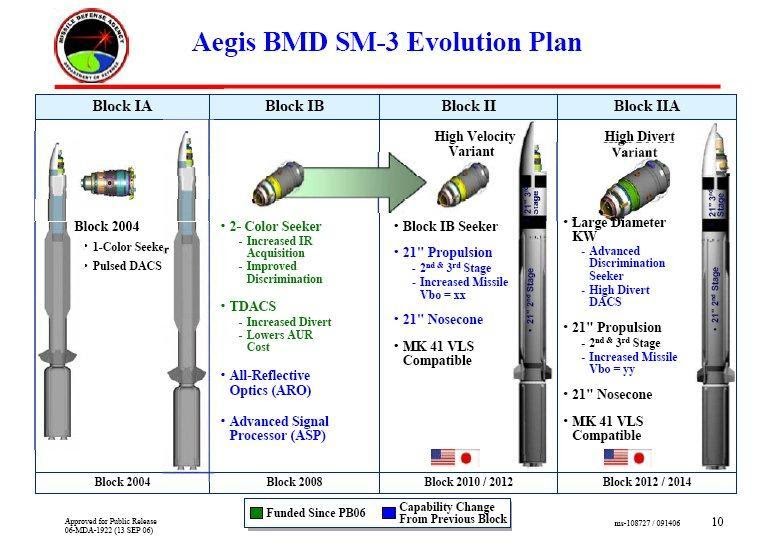
Aegis ballistic missile defence SM-3 evolution plan, Source: US Missile Defense Agency [11]
On 3 February 2016, four days before the DPRK launched a long-range rocket using BM technology (Taepodong 2) on 7 February, the Japanese Defense Minister ordered the BMD units of the Japanese Self-Defense Forces (SDF) to destroy incoming BMs that could land on its territories. [12] On 3 August 2016, the DPRK simultaneously launched two medium-range BMs (Nodong missiles), one of which landed within Japan's exclusive economic zone. [13] As a consequence, from August 2016 through around June 2018, the SDF's BM units were put on alert at all times, which imposed significant burdens on their activities. [14] In December 2017, the Abe administration decided to introduce two units of the land-based BMD system "Aegis Ashore" [15] to seamlessly defend Japan's entire territory at all times while relieving the burden on the personnel of BMD units, especially those onboard the Aegis destroyers at sea.
The Japan Maritime Self-Defense Force (JMSDF) is responsible for the operation of the Aegis destroyers. As the JMSDF was overwhelmed by the missile defence operations, its other operations, especially those related to the protection of the remote Japanese islands or anti-submarine warfare, were affected due to the resource constraints. The introduction of the Aegis Ashore was expected to relieve the burdens on the JMSDF as the land-based missile defence system were to be managed by the Japanese Ground Self-Defense Force (JGSDF).
The radar units for the Aegis Ashore, SPY-7, are considered to be superior to those used for Aegis-equipped destroyers as the former possessed enhanced capabilities against BMs launched with a lofted trajectory and against simultaneous saturation missile attacks.

The Aegis Ashore system deployed on the Deveselu Base, Romania, May 2016, Source: NATO [16]
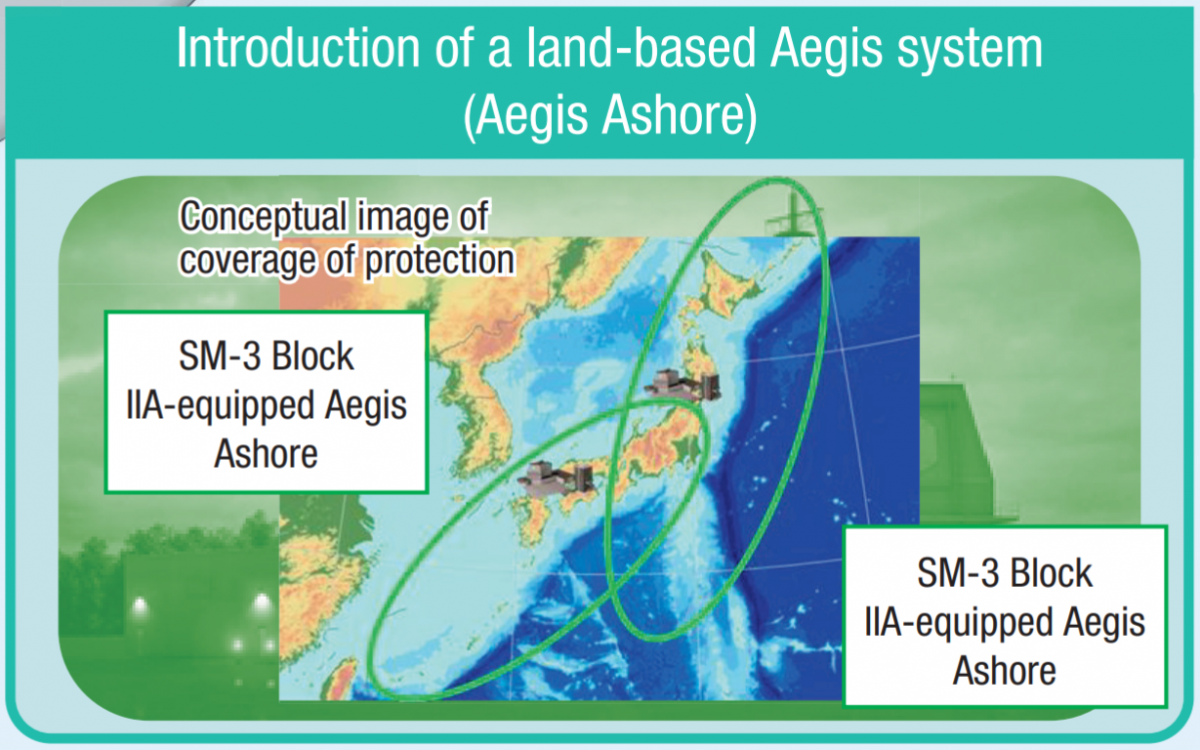
Conceptual image of the geographical coverage areas of the Aegis Shore units, Source: Japan MOD [17]
Japan's MOD explained that, when the interceptor (SM-3) was fired, the booster of the interceptor would fall either within the Ground Self-Defense Force's firing areas or at sea, avoiding the residential areas surrounding the firing areas. In May 2020, however, it became clear that, in order to control the fly-out trajectories of the SM-3 interceptor, the entire Aegis Shore system would have to be refurbished, which could require a considerable additional investment of cost and time. In consideration for the safety of the residents surrounding the firing areas, then Japanese Defense Minister Taro Kono decided in June 2020 to suspend, and then to give up, the plan to deploy the Aegis Ashore. This decision was also authorized by Prime Minister Abe.
According to a senior defence official, Minister Kono made the decision without full consultation within the MOD. The senior official questioned why the risk of the interceptor's booster falling into the residential area outweighed the risk of a BM striking a Japanese city at a time of war. [18]
Regardless, the decision is no longer revisited. However, it triggered a renewed debate in Japan as to what would be the optimal concept for an effective Japanese missile defence architecture.
Emerging Missile Threats: Japan's View
When Japan started to develop its ballistic missile defence architecture in 2004, it was based on two assumptions: (1) Japan would be able to detect signs of preparation for BM launches by the adversary at an early stage; and (2) Japan would have time to prepare for launching the interceptors. Over the years, however, both the DPRK and the PRC improved strike capabilities for saturation- and/or surprise attacks by using missiles with enhanced maneuverability, which have complicated Japan's ability to intercept incoming missiles. By way of example, the DPRK's use of transporter erector launchers (TELs) and solid fuel for BM launches, and its development of submarine-launched BMs, have made it increasingly challenging for Japan to detect at an early stage the DPRK's preparation for missile launches. [19]
Officially, Japan refers only to the "grave and imminent" threats posed by the DPRK's missiles when justifying its BMD strategy and policies, and avoids referring to those of the PRC and the Russian Federation out of diplomatic considerations. In reality, however, Japan has been concerned about missile development by the latter two countries as well, and considers that especially the PRC poses the most significant strategic challenges to Japan’s security. Japan's National Defense Program Guidelines (JNDPG) of 18 December 2018 warned, "China engages in unilateral, coercive attempts to alter the status quo based on its own assertions that are incompatible with existing international order," citing the PRC's expanding and intensifying military activities at sea and in the air surrounding Japan as well as the South China Sea. [20] The JNDPG also stated: "Such Chinese military and other developments, coupled with the lack of transparency surrounding its defense policy and military power, represent a serious security concern for the region including Japan and for the international community." [21]
Japan is also concerned about the PRC's efforts to improve its missiles' existing capabilities by extending ranges, enhancing targeting accuracy and employing maneuverable reentry vehicles (MaRVs) and multiple independently targetable reentry vehicles (MIRVs) as well as improving their survivability and readiness. [22]
Japan further assesses that the PRC is rapidly developing several hypersonic glide vehicles (HGVs) that could be launched with ballistic missiles, such as the DF-17 MRBM, to penetrate missile defenses. The HGVs are considered to be difficult to intercept by existing missile defence systems because they can fly low at very high speeds and with high maneuverability. [23]
As described above, the discussion in Japan about how the Japanese missile defence architecture has to cope with the emerging new weapon systems is evolving.
Under these circumstances, the Japanese Government and the ruling party politicians consider that Japan must drastically upgrade its missile defense capabilities. [24]
Japan Pursuing "a New Course" in Countering Missiles
The government's decision to abandon the Aegis Shore option prompted the ruling supermajority Liberal Democratic Party (LDP) to revisit the ability of the existing missile defence architecture to meet the various emerging security challenges. On 4 August 2020, the LDP's Policy Affairs Research Council (PARC) urged the Japanese Government to adopt new initiatives to strengthen Japan's deterrence. The LDP-PARC proposed that Japan should strengthen its deterrence by adopting the concept of "integrated air missile defence (IAMD)" including "Japan's possession of the capabilities to prevent the missiles and others within the adversary's territories."
While the exact meaning of this recommendation appears obscure, it implies Japan's ability to strike missile-related targets within an adversary's territory, such as missile launch pads and related infrastructure, as part of the Japanese missile defence strategy (hereafter, "the new conditional counterforce strike capabilities"). The LDP-PARC noted that this recommendation was conditional: Japan's possession of such capabilities should be carried out within the constitutional limitation and in line with Japan's policy of exclusive self-defence and international laws. [25]
The chair of the National Defense Division of the LDP-PARC at that time was Itsunori Onodera, a former Japanese Defense Minister, who takes the view that under the Japanese Constitution, Japan would be permitted to strike enemy missile sites only after Japan had absorbed or defeated the first strike. He argues that Japan's policy of exclusive self-defense only allows Japan to strike back at limited targets in an adversary's territory and that such strikes should be carried out only as part of Japan's missile defence strategy, namely, prevention of a second launch of hostile missiles against Japan.
Reportedly, the aforementioned ambiguous phrase used in the LDP-PARC proposal was the result of a compromise within the LDP between those who support such capabilities and those who oppose the introduction of the new conditional counterforce strike capabilities due to security concerns that such capabilities could violate Japan's traditional policy of exclusive self-defence and would invite unwanted arms race in East Asia. [26] However, the 2020 recommendation has toned down from the previous LDP-PARC's recommendations issued in 2017 and 2018 which explicitly stated that Japan should examine the option to possess indigenous capabilities to strike the missile sites on the adversary's territories. [27]
While all politicians seem to agree that any new missile defence capabilities should not exceed the constitutional limitation, there are diverging views with regard to what is allowed within the constitutional limitation. In addition, there are different assessments as to what would be the optimum balance between securing Japan's defence against missile attacks and the associated risk of an escalating arms race in the region.
Mr. Abe's Statement
On 28 August 2020, Mr. Abe publicly questioned whether Japan could defend itself from adversarial missile attacks simply by enhancing Japan's capability to intercept incoming missiles, citing the improvements of the DPRK's ballistic missile capabilities as a source of major concern. [28]
In this context, Mr. Abe issued a statement on 11 September 2020, one of his final acts as the prime minister. In this statement, Mr. Abe did not provide any concrete information regarding how Japan's missile defense strategy would be changed, and instead simply stated that the Japanese Government would decide on the specifics by the end of 2020. Nevertheless, Mr. Abe reiterated his skepticism about the reliability of the existing missile defense architecture stating, "there is a question of whether it is possible to protect and defend the lives and the peaceful livelihoods of the Japanese people only by enhancing our interception capability." [29] He also stated that "the Government of Japan has been considering a new course for security policy regarding countering missiles," indicating Japan's ongoing examination of the new conditional counterforce strike capabilities.
While Mr. Abe stopped short of providing specifics, he also made it clear that deliberation over the "new course" was "being carried out within the scope of the Constitution and in compliance with international law." In addition, he stated that "Japan's exclusively defense-oriented policy will not change at all. Nor will the basic role and mission sharing between Japan and the United States."
From a legal point of view, Japan's exclusively self-defence policy under the Japanese Constitution allows Japan to carry out limited strikes against foreign military bases within certain limits, specifically, "absolute minimum measures that are unavoidably necessary to defend against a missile attack … if no other suitable means are available." [30] It is generally interpreted that the Constitution does not allow Japan to undertake counter-value strikes against large cities or large populations. [31]
In effect, Mr. Abe declared in this statement that Japan's position was that the country would not pursue indigenous strike capabilities independently from the Japan-United States alliance. Instead, his statement appears to have pointed to Japan's intention to consult with the United States to explore areas where Japan can complement or cooperate with US strike capabilities.
On 16 September, 5 days after the issuance of his statement, Mr. Abe resigned and Yoshihide Suga, who had been the Cabinet Secretary under Abe's administration, was elected as the next Japanese Prime Minister. Mr. Suga thus became responsible for shaping the "new course" for Japan's missile defence strategy.
A Pivot…? The Cabinet's Decisions of 18 December 2020
It should be noted that Mr. Abe's aforementioned statement was not approved by his Cabinet; it reflects his personal view and does not necessarily reflect an official consensus position of the Japanese Government, though he noted that the Japanese Government would consult the ruling parties closely. Since December 2012, the Japanese Government has been led by a coalition of the supermajority LDP and another liberal party, Komeito. The latter has yet to formulate its position on how to upgrade the missile defence systems, but the Komei Party's leaders have already repeatedly expressed concerns about Japan’s possession of the new conditional counterforce strike capabilities.
During a press conference held in September 2020, Mr. Suga stated that he would continue to shape Japan's national security policy based on the Japan-U.S. alliance. [32] He also stated that he would continue to elaborate on upgrading Japan’s missile defence strategy. [33] However, he also stated that he would not set a timeframe as to when the elaboration should be completed. [34] On 4 November, during a meeting of the Budget Committee of the House of Representatives, Mr. Suga clarified that Mr. Abe's statement had not been approved by the Cabinet and that the statement did not hold "binding power over the subsequent Cabinets," [35] which seemed to indicate Mr. Suga's intention to maintain a certain distance from Mr. Abe's position on the conditional counterforce strike capabilities. There is little doubt that this statement was made taking into account that Mr. Suga has to maintain a coalition with the Komei Party in order to prepare for the national election in 2021.
While Mr. Abe is no longer leading the Japanese Government, he remains a key figure in the ruling party, the LDP, and in pressing for Japan's possession of conditional counterforce strike capabilities. On 16 November, he made a speech during a LDP meeting in which he stated, "It is natural [for Japan] to possess strike capabilities" and "I believe that Prime Minister [Suga] will also take my statement seriously for further examination." [36]
The first decision on the missile defence policy by Prime Minister Suga and his Cabinet was released on 18 December. The decision was to introduce two Aegis system-equipped vessels as a replacement for the land-based Aegis Shore systems. [37] Further details are to be decided. There was no reference to the conditional counterforce strike capabilities in the Cabinet decision which, instead, simply stated that "the Government will continue to examine the matter of strengthening deterrence capabilities." [38]
The decision prompted another round of criticism and debate in Japan about the technical and operational feasibility associated with the sea-based Aegis systems, which are expected to incur significant additional costs and burdens on the JMSDF. There is a growing concern in Japan that the JMSDF is already experiencing a personnel shortage and could experience considerable difficulties in engaging in other missions, especially anti-submarine warfare or the protection of the Japanese Southwestern Islands from invasion by hostile forces, especially in the event of a military contingency surrounding Taiwan.
Simultaneously, the Cabinet also decided to strengthen Japan's "stand-off defence capabilities" by upgrading Type-12 surface-to-ship guided missiles. According to this decision, the near-future stand-off missiles are expected to become capable of striking hostile forces invading Japanese remote islands from outside the ranges of the opponent's air-defense capabilities. The upgraded stand-off missiles are to be launched from various platforms, including naval vessels and/or fighter jets. [39]
These standoff missiles are planned to be used to defend Japan's remote islands that are located off the Kyushu islands and in the Okinawan archipelago in the event of a military contingency surrounding Taiwan. There is speculation among the media and experts that these standoff missiles could possess counterforce strike capabilities against neighbouring countries if their ranges were to be extended beyond 1,500 kilometers. [40] Some media speculates that these aforementioned two decisions likely reflect Mr. Suga's intention to accommodate the conflicting views between Mr. Abe, who presses for conditional counterforce strike capabilities, and the liberal Komei Party, which opposes such capabilities.
It is unclear whether, and if so when, Mr. Suga might make a clear decision on the conditional counterforce strike capabilities. Mr. Abe acknowledged himself that it might take some time for the Suga Administration to make the decision because of the coming election in 2021 which requires cooperation with the Komei Party. [41]
Irrespective of the political uncertainty, the Japanese MOD and the LPD politicians continue to elaborate upon the future course of the missile defence systems.
Factors Affecting Japan's Decision on Its Missile Defence Strategy
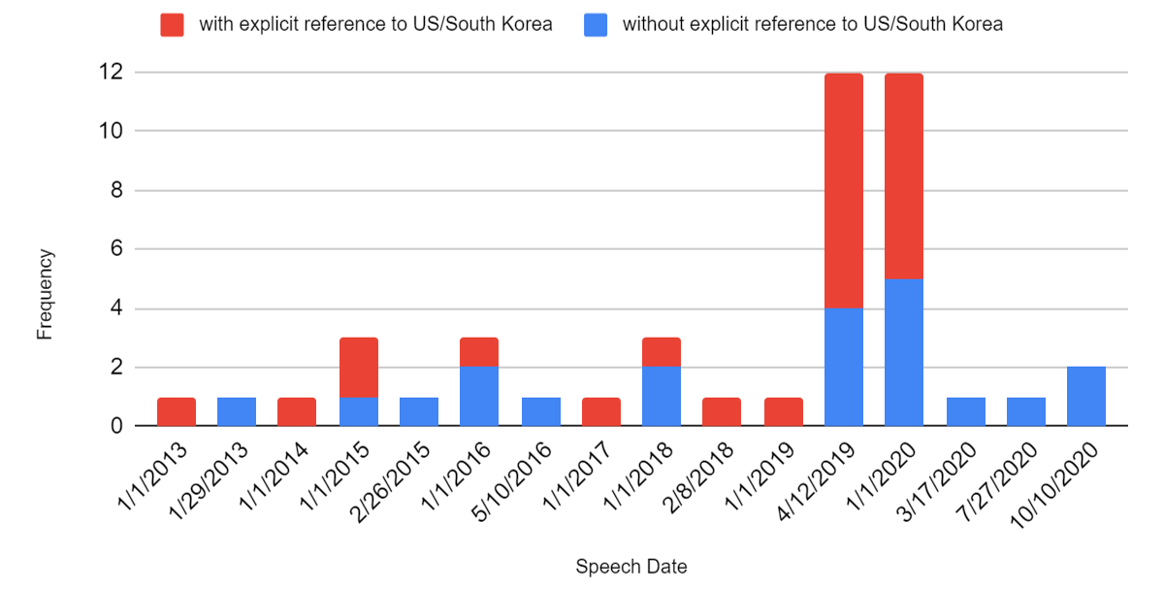
The Japanese Aegis destroyer Atago just after launching the SM3 Block 1B interceptor, off the coast of Hawaii, the United States, 12 September 2018, Source: Japan MOD [42]
Japan's decisions related to its missile defence policy has been, and will continued to be, impacted by several key factors, especially the following: (1) domestic consensus; (2) budgetary constraints; (3) technical feasibility; and (4) US response.
Any decision will be shaped through the efforts to construct a domestic consensus. This is important for the Japanese Government especially given the significant size of the defence budget required for any change in the missile defence systems, which would compete against budgetary requirements for other policies. Japan already faces significant budgetary constraints because of the accumulated budget deficit, which had reached 200% of its GDP as of March 2020, leaving little room for further major increase in an annual defence budget. [43] A Cabinet decision to introduce additional 2 Aegis system-equipped vessels is expected to require significant additional costs. In order for Japan to possess the conditional counterforce strike capabilities, the Japanese Government will have to find the necessary funds. This task is not easy for Prime Minister Suga because he will need to obtain an agreement from the Komei Party which maintains its opposition to such a policy. Consensus from the coalition partner is indispensable for any Japanese prime minister.
From a technical point of view, Japanese experts and some defence officials argue that it might be possible to convert the upcoming stand-off missiles into new missiles for counterforce strike operations, considering that it would be the most cost effective and technically feasible option for Japan to strike a military target in a neighbouring country. [44] It should be noted that if Japan were to adopt this option, it would have to drastically extend the ranges of these missiles and develop the means for detection, tracking and targeting of the missiles on the adversary's territories. Those programmes would also require a considerable additional budget.
Furthermore, the Japanese Government has expressed its intention repeatedly to fit its missile defence systems within the framework of the Japan-US alliance. Considering the political reality that Japan's security relies heavily upon the bilateral alliance with the United States, and also given the considerable Japanese budgetary constraints, it would be difficult for Japan to deviate from the bilateral alliance with the United States.
Japan has also attempted to coordinate its defence policy within the perimeter of the Japan-US-ROK security cooperation. Currently, there is a concern among the Japanese national security community that Japan is not involved in the US-ROK planning for selecting priority targets within the DPRK in the event of a contingency on the Korean Peninsula, and therefore, the US-ROK alliance may prioritize the defence of their homelands by neutralizing the DPRK's short- and long-range ballistic missiles first while putting off the military strikes against the DPRK's medium-range ballistic missiles that could reach Japan. [45]
The Japanese Prime Minister Suga and his Cabinet already decided their foreign policy on 16 September 2020, which stated that Japan would build stable relations with neighboring countries including the PRC. Reportedly, there are diverging views within the LDP and also within the Japanese Government about how Japan should balance its strong national security posture against the PRC and its close economic relationship with the PRC. [46]
Mr. Suga will have to continue to strike the best balance cautiously between efforts to upgrade the missile defence systems and efforts to minimize its negative impacts on Japan's diplomatic relationship with the neighbouring countries.
Japan's pursuit of a "new course" for its missile defence strategy still continues.
[1] The Prime Minister of Japan and His Cabinet, Press Conference by the Prime Minister Abe (安倍内閣総理大臣記者会見), 18 June 2020, available at: https://www.kantei.go.jp/jp/98_abe/statement/2020/0618kaiken.html
[2] The Prime Minister of Japan and His Cabinet, Statement by the Prime Minister, 11 September 2020, available at: https://japan.kantei.go.jp/98_abe/statement/202009/_00002.html
[3] The official YouTube channel of the Japanese Ministry of Defense, available at: https://www.youtube.com/watch?v=WRAfkuoQeMQ&feature=youtu.be
[4] The Japanese Ministry of Defense, Defense of Japan 2020, p. 257
[5] The Japanese Ministry of Defense, Defense of Japan 2020, p. 256, available at: https://www.mod.go.jp/e/publ/w_paper/wp2020/pdf/R02030102.pdf
[6] The homepage of the Japanese Air Self-Defense Force, available at: https://www.mod.go.jp/asdf/equipment/other/Patriot/index.html
[7] The Japanese Ministry of Defense, Defense of Japan 2020, p. 258
[8] The Japanese Ministry of Defense, Defense of Japan 2020, pp. 258-259
[9] The Japanese National Security Council and the Cabinet, Medium Term Defense Program (FY 2019 - FY 2023), 18 December 2018, available at: https://www.mod.go.jp/j/approach/agenda/guideline/2019/pdf/chuki_seibi31-35_e.pdf
[10] The Japanese Ministry of Defense, Defense of Japan 2020, p. 259
[11] A materiel produced by the US Missile Defense Agency for public release, available at: https://www.globalsecurity.org/jhtml/jframe.html#https://www.globalsecurity.org/space/systems/images/sm-3-image27.jpg|||
[12] The Japanese Ministry of Defense, The Self-Defense Forces Activity Order to carry out destruction measures against the ballistic missiles (弾道ミサイル等に対する破壊措置等の実施に関する自衛隊行動命令について), 3 February 2016, available at: https://www.mod.go.jp/j/press/news/2016/02/03b_1.html
[13] According to the explanation by the Japanese Government at the time, the Government determined prior to the impact of these missiles with the Japanese EEZ that these missiles would apparently not cause any harm to Japanese territories and therefore they did not intercept the incoming missiles.
[14] MOD relieved the DPRK missile alert posture after the US-DPRK summit meeting but maintained the missile destruction order (防衛省、北朝鮮のミサイル警戒態勢を緩和 米朝対話受け 破壊措置命令は維持), The Sankei News online, 2 July 2018, available at: https://www.sankei.com/politics/news/180702/plt1807020040-n1.html
[15] Aegis Ashore refers to a missile defense system that consists of radars, a command communication system and a vertical launch system similar to Aegis-equipped destroyers but deployed on the ground. Aegis Ashore conducts exoatmospheric interception of flying ballistic missiles from a fixed ground position. See: The Japanese Ministry of Defense, Defense of Japan 2020, p. 260
[16] NATO, Aegis Ashore ballistic missile defence system in Romania completes scheduled update, 9 August 2019, available at: https://www.nato.int/cps/en/natohq/news_168377.htm?selectedLocale=en
[17] The Japanese Ministry of Defense, Defense of Japan 2020, p. 259
[18] The author's meeting with a senior Japanese defence official on 3 December 2020 in Tokyo, Japan.
[19] Since 2016, the DPRK has conducted three nuclear weapon tests and launched more than 70 missiles. The Japanese MOD has assessed that the DPRK already possesses and has deployed several hundred BMs capable of reaching almost anywhere in Japan. Some of the DPRK's missiles that were launched in 2019 can fly at a lower altitude than conventional BMs and on an irregular trajectory, likely with the objective to defeat BMD systems. Japan considers the DPRK’s military actions as a source of "grave and imminent threats to Japan's security." See: The Japanese Ministry of Defense, Defense of Japan 2020, p. 257, available at: https://www.mod.go.jp/e/publ/w_paper/wp2020/pdf/R02030102.pdf
[20] The Japanese National Security Council and the Cabinet, National Defense Program Guidelines for FY 2019 and beyond, 18 December 2018, p. 5, available at: https://www.mod.go.jp/j/approach/agenda/guideline/2019/pdf/20181218_e.pdf
[21] The PRC possesses BMs of various types and ranges, including intercontinental ballistic missiles (ICBMs), SLBMs, intermediate-range ballistic missiles (IRBMs), medium-range ballistic missiles (MRBMs) and short-range ballistic missiles (SRBMs). Japan assesses that the PRC focuses on improving its capabilities to penetrate the missile defense systems of the United States and its allies and the amphibious landing capabilities in order to improve the so-called Anti-Access/Area Denial ("A2/AD") capabilities that are intended to deny access and deployment of the US military forces to the East Asian region and to disrupt the US military operations therein. Japan considers that these capabilities would enable the PRC to conduct military operations over greater distances. See: The Japanese National Security Council and the Cabinet, National Defense Program Guidelines for FY 2019 and beyond, 18 December 2018, p. 5, available at: https://www.mod.go.jp/j/approach/agenda/guideline/2019/pdf/20181218_e.pdf
[22] The PRC possesses the mobile solid-propellant DF-21 BM and DF-26 BM which are nuclear-capable and can cover the Indo-Pacific region, including Japan. The DF-21D anti-ship ballistic missile (ASBM) is referred to as a "carrier killer" since it can be used to attack aircraft carriers and other naval vessels. The DF-26 has a range covering Guam, (and hence referred to as the "Guam killer"), and is considered a "second-generation ASBM." The PRC also possesses the CJ-10 and the CJ-20, long-range land-attack cruise missiles (LACMs) with a range of at least 1,500 km. According to the US Department of Defence, the CJ-20 can be carried by the H-6 bomber and cover Japan. Japan is also worried about the CJ-100/DF-100 which is considered to be a supersonic cruise missile. Japan views the deployment of these missiles as a means of strengthening the PRC's "A2/ AD" capabilities. As for the SRBMs, China has deployed a large number of solid-propellant DF-16, DF-15, and DF-11 missiles across Taiwan. Japan assesses that their ranges cover a part of Japan's Southwestern Islands, including the Senkaku Islands which are contested both by Japan and by the PRC. See: The Japanese Ministry of Defense, Defense of Japan 2020, pp. 61-63
[23] The Japanese Ministry of Defense, Defense of Japan 2020, p. 62
[24] The Japanese Ministry of Defense, Defense of Japan 2020, p. 260
[25] The LDP-PARC, Recommendations for enhancing Japan's deterrence capability in order to protect the nationals (国民を守るための抑止力向上に関する提言), 4 August 2020, available at: https://jimin.jp-east-2.storage.api.nifcloud.com/pdf/news/policy/200442_1.pdf
[26] The Asahi Newspaper, Interview with former defence minister Tsuyoshi Iwaya: The capabilities to strike enemy base would deviate from Japan's exclusive self-defence policy (敵基地攻撃能力、専守防衛を逸脱 岩屋毅・前防衛相), 28 July 2020, available at: https://digital.asahi.com/articles/DA3S14565052.html
[27] The National Defense Division (国防部会) of the LDP-PARC, Recommendations regarding the New National Defense Program Outline (提言・新防衛計画の大綱について), 2017, available at: https://www.jimin.jp/policy/policy_topics/pdf/seisaku-017.pdf
[28] The Prime Minister of Japan and His Cabinet, Press Conference by the Prime Minister Abe (安倍内閣総理大臣記者会見), 28 August 2020, available at: https://www.kantei.go.jp/jp/98_abe/statement/2020/0828kaiken.html
[29] The Prime Minister of Japan and His Cabinet, Statement by the Prime Minister, 11 September 2020, available at: https://japan.kantei.go.jp/98_abe/statement/202009/_00002.html
[30] Reply of Prime Minister Ichiro Hatoyama which was read by Minister of State for Defense Naka Funada at the 24th House of Representatives Cabinet Committee Meeting Minutes, No. 15, 29 February 1956, p. 241. The English translation of this reply is available at the following article: Sugio Takahashi, Dealing with the Ballistic Missile Threat: Whether Japan Should Have a Strike Capability under its Exclusively Defense-Oriented Policy, NIDS Security Reports, No.7, September 2006, p. 81, available at: http://www.nids.mod.go.jp/english/publication/kiyo/e2006.html
[31] The Japanese Constitution prohibits, in any circumstance, the possession of so-called offensive weapons with capabilities that are mainly aimed at catastrophic destruction of the target country, because such capabilities would exceed the minimum limit necessary for self-defence. See: The Japanese Government's position on the meaning of the Article 9 of the Constitution (憲法第9条の趣旨についての政府見解), available at: http://www.clearing.mod.go.jp/hakusho_data/2010/2010/html/m2122100.html
[32] Press conference by Prime Minister Yoshihide Suga, 16 September 2020, available at: https://www.kantei.go.jp/jp/99_suga/statement/2020/0916kaiken.html
[33] Press conference by the Cabinet Secretary in the morning of 14 September 2020, available at: https://www.kantei.go.jp/jp/tyoukanpress/202009/14_a.html
[34] Press conference by the Cabinet Secretary in the afternoon of 2 September 2020, available at: https://www.kantei.go.jp/jp/tyoukanpress/202009/2_p.html
[35] A statement by Prime Minister Suga during a meeting of the Budget Committee of the House of Representatives in the 203 session of the National Diet, 4 November, 2020, available at: http://www.shugiin.go.jp/internet/itdb_kaigiroku.nsf/html/kaigiroku/001820320201104003.htm
[36] Taizo Teramoto and Yuuki Nikaido, Mr. Abe pressed for the option to possess strike capabilities against the adversary's military bases, and Mr. Suga's response is… (「敵基地攻撃」能力保持、迫った安倍氏 菅首相の答えは), Asahi Newspaper online, 19 December 2020, available at: https://digital.asahi.com/articles/ASNDL6W8CNDLUTFK024.html. http://www.shugiin.go.jp/internet/itdb_kaigiroku.nsf/html/kaigiroku/001820320201104003.htm
[37] The decision by the Japanese Cabinet and the Japanese National Defense Council, Procurement of a New Missile Defense System, etc. and Strengthening Stand-off Defense Capability, 18 December 2020, a provisional English translation is available at: https://www.mod.go.jp/j/approach/agenda/guideline/2019/pdf/Defense_Program_e_2020.pdf
[38] Ibid.
[39] The Japanese MOD, Report on evaluation of the 2020 policies (令和2年政策評価書), December 2020, available at: https://www.mod.go.jp/j/approach/hyouka/seisaku/2020/pdf/jizen_08_honbun.pdf
[40] Developing a domestic "Tomahawk missile," a new surface-to ship missile with a range of 2000 kilometers, the Type 12 SSM's range to be extended up to 1500 kilometers (国産トマホーク」開発へ 射程2千キロの新型対艦弾 12式は1500キロに延伸), The Sankei News online, 29 December 2020, available at: https://www.sankei.com/politics/news/201229/plt2012290001-n1.html
[41] Former Prime Minister Abe acknowledged to postpone the decision on the counterforce strike capabilities (年内結論先送りを容認 敵基地攻撃能力で安倍前首相), Jiji.com, 16 November 2020, available at: https://www.jiji.com/jc/article?k=2020111600712&g=pol
[42] The official YouTube channel of the Japanese Ministry of Defense, available at: https://www.youtube.com/watch?v=WRAfkuoQeMQ&feature=youtu.be
[43] The Japanese Ministry of Finance, Japan's Fiscal Situations (わが国の財政事情), December 2019, available at: https://www.mof.go.jp/budget/budger_workflow/budget/fy2020/seifuan2019/04.pdf
[44] The author's conversation with a JGSDF officer, 30 July 2020, in Ohmiya City, Saitama Prefecture, Japan.
[45] For example, see the following article: Masahi Murano, How to cope with the DPRK’s enhancement of the nuclear and missile capabilities (北朝鮮の核・ミサイル能⼒向上にどう対処するか), SYNODOS, 5 March 2018, available at: https://synodos.jp/international/21181
[46] The Prime Minister of Japan and His Cabinet, Cabinet decision on basic policy, 16 September 2020, available at: https://japan.kantei.go.jp/99_suga/decisions/2020/_00001.html